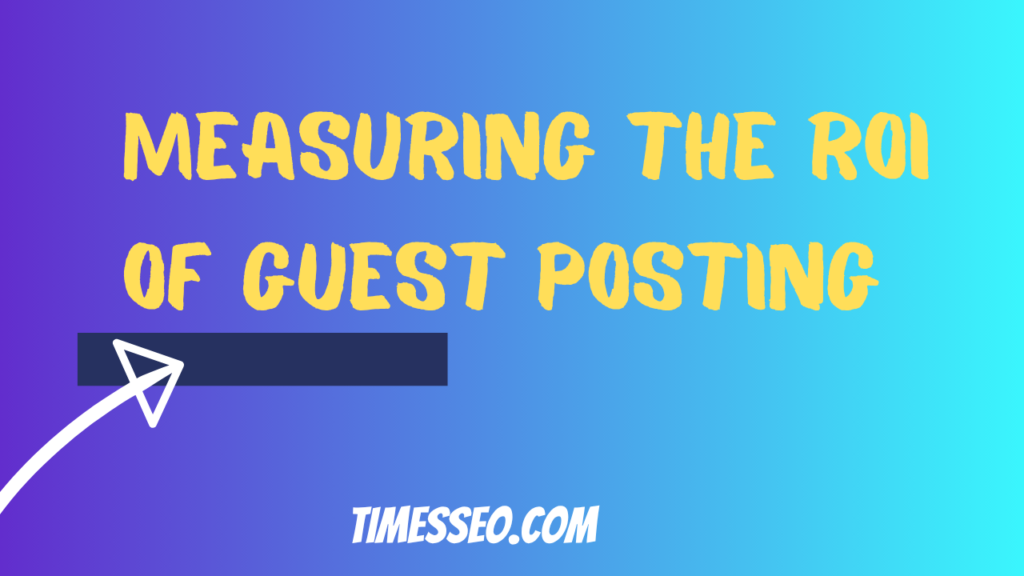
Using Guest Posts for Building Niche Relevant Backlinks
Discover how guest posting can supercharge your SEO strategy in our latest blog post, “Using Guest Posts for Building Niche Relevant Backlinks.” Learn practical tips, proven strategies, and outreach techniques to begin constructing relevant backlinks in your niche, which will increase the authority, ranks, and organic traffic of your website.
Table of Contents
Introduction
If you’ve ever tried climbing the Google ranks, you’ve likely heard the phrase “Backlinks are king.” But not just any backlinks—niche relevant backlinks are the real crown jewels. In this article, we’ll dive deep into how guest posts can be your secret weapon for getting high-quality, relevant backlinks that actually move the SEO needle.
What Are Guest Posts?
Guest posts are articles that you produce and post on another person’s website or blog, usually in return for a backlink. Back in the day, they were more of a PR move. Now, they’re a tactical SEO strategy when done right.
Over the years, guest posting has evolved. Google’s algorithm got smarter, and so did marketers. It’s no longer about mass-producing generic content. Quality and relevance now drive real results.
Why Use Guest Posts for Backlinks?
Authority Building
When your content appears on established websites, it rubs off some of their authority onto yours. Think of it like being featured in a top magazine—it builds credibility and trust.
Referral Traffic Benefits
Besides improving SEO, guest posts can also bring genuine traffic to your website. When the audience aligns with your niche, the traffic tends to stick around, engage, and convert.
Building Relationships in Your Industry
Guest blogging opens the door to networking. It positions you as a thought leader and builds connections with site owners and readers alike.
Niche Relevance: The Secret Sauce
What Makes a Backlink Niche Relevant?
A niche relevant backlink comes from a site or article that directly relates to your industry or topic. For instance, a backlink from a fitness blog to your yoga product site is relevant. One from a pet grooming blog? Not so much.
Search Engines and Relevance Signals
Google looks at more than just the link. It considers the page topic, anchor text, surrounding content, and even the overall site theme. That’s why relevance is key—it sends stronger trust signals.
Finding the Right Guest Posting Opportunities
Using Google Search Operators
Use queries like:
- “write for us” + [your niche]
- “guest post guidelines” + [your niche]
- inurl:guest-post + [your topic]
Tools to Discover Guest Posting Sites
Platforms like:
- Ahrefs
- SEMrush
- BuzzSumo
- NinjaOutreach
These can help you filter sites by authority, topic relevance, and guest posting history.
Analyzing Site Metrics and Audience Fit
Don’t just chase Domain Authority (DA). Look at engagement, audience type, posting frequency, and spam score. A DA 30 site with the right audience often beats a DA 70 with no relevance.
How to Submit Acceptable Guest Posts
Crafting a Killer Outreach Email
Short, sweet, and personalized wins. Mention something specific about their blog, share your idea, and link to writing samples. Example:
“Hi Sarah, I loved your post on sustainable fashion. I’d love to contribute something fresh for your readers, like ‘5 Eco-Friendly Fabrics That Don’t Break the Bank’. Would that be a good fit?”
Personalization vs. Templating
Templates save time but kill conversions. Customize the first few lines. It shows effort.
Common Mistakes to Avoid
- Being vague
- Offering irrelevant topics
- Sounding robotic
- Forgetting writing samples
Writing a Guest Post That Adds Value
Aligning with the Host Blog’s Voice
Read a few posts. Are they casual or technical? Long-form or short? Match the tone and structure.
SEO Optimization Without Overdoing It
Yes, optimize. But don’t stuff keywords. Use them naturally in headers, intro, and conclusion. Include internal links if allowed.
Providing Actionable, Unique Content
Avoid regurgitated tips. Share personal insights, data, case studies, or step-by-step guides.
Including Backlinks in Guest Posts
Where and How to Place Backlinks Naturally
- In a relevant paragraph
- As a resource or additional reading
- Avoid linking just for the sake of it
Anchor Text Best Practices
Use a mix of:
- Branded anchor text
- Partial-match keywords
- Natural phrases (e.g., “this guide”)
Contextual Linking vs. Author Bio Links
Contextual links (within the article body) carry more SEO value than links in the author bio. Aim for both if possible.
Measuring the ROI of Guest Posting
Tracking Backlink Indexing
Use tools like Ahrefs or Google Search Console to verify whether your backlinks are live and indexed.
Monitoring Traffic & Rankings
Look for spikes in referral traffic. Over time, track keyword ranking improvements tied to guest post campaigns.
Long-Term Brand Building
Guest posts also help establish your brand’s voice and footprint across the web.
Avoiding Black-Hat Tactics
Risks of Paid Guest Posts
Google frowns on paid links. If you’re paying, make sure it’s disclosed or no-followed to avoid penalties.
PBNs and Footprint Issues
Private Blog Networks (PBNs) may seem tempting but are risky. They often have low-quality content and obvious footprints.
Case Studies of Successful Guest Posting Campaigns
- Example 1: A SaaS brand gained 15k monthly organic traffic by publishing 30 high-quality guest posts over 6 months.
- Example 2: A health coach boosted domain authority from 12 to 40 using niche blogs in fitness and wellness.
Outsourcing Guest Posting: Pros and Cons
Freelancers vs. Agencies
- Freelancers are cheaper but harder to manage.
- Agencies offer full service but can be pricey.
What to Watch Out For
- Fake metrics
- Low-quality networks
- Non-relevant sites
Always request writing samples and live links.
Common Challenges and How to Overcome Them
Rejections
Don’t take it personally. Follow up politely, or move on to the next prospect.
Time Management
Batch your outreach. Set aside time every week to follow up and pitch.
Scalability
Once you’ve nailed the process, use templates (personalized, of course) and hire help to scale.
Tools to Help with Guest Posting
- BuzzStream: For managing outreach.
- Grammarly: To polish your writing.
- Ahrefs: For backlink monitoring.
- Hunter.io: To find email addresses.
- Trello: To organize your campaign.
Conclusion
Guest posting isn’t just another link-building tactic—it’s a relationship and credibility builder that can pay off big time. When done thoughtfully and consistently, it’s a game-changer for getting niche relevant backlinks that help you rank higher, faster, and longer.
Frequently Asked Questions
Unique insights, actionable content, proper formatting, and aligning with the blog’s tone make a post high quality.
One to two backlinks is ideal—any more can seem spammy unless it’s a very long post.
Not necessarily. Always confirm with the site owner. Some may add a no-follow tag by default.
Typically, 2 to 6 months depending on your domain age, competition, and posting frequency.
Absolutely. You can hire editors, use writing tools, or even outsource the entire article creation.
Table of Contents
Popular Posts
-
 Affordable Technical SEO Audit for Small Business: A Complete Guide26 Jun 2025 Blog
Affordable Technical SEO Audit for Small Business: A Complete Guide26 Jun 2025 Blog -
 How to Get an Affordable Technical SEO Audit for Small Business27 Jun 2025 Blog
How to Get an Affordable Technical SEO Audit for Small Business27 Jun 2025 Blog -
 The Ultimate Local SEO Audit Checklist for Startups28 Jun 2025 Blog
The Ultimate Local SEO Audit Checklist for Startups28 Jun 2025 Blog -
 Local SEO Audit Checklist for Startups: A Beginner’s Guide28 Jun 2025 Blog
Local SEO Audit Checklist for Startups: A Beginner’s Guide28 Jun 2025 Blog -
 Top On-Page SEO Audit Steps for Service Websites Every Business Should Know29 Jun 2025 Blog
Top On-Page SEO Audit Steps for Service Websites Every Business Should Know29 Jun 2025 Blog -
 Technical SEO for WordPress: The Ultimate Beginner’s Guide01 Jul 2025 Blog
Technical SEO for WordPress: The Ultimate Beginner’s Guide01 Jul 2025 Blog -
 The Impact of On-Page SEO Audit Steps for Service Websites on UX01 Jul 2025 Blog
The Impact of On-Page SEO Audit Steps for Service Websites on UX01 Jul 2025 Blog -
 Technical Mobile SEO Audit Tips for Developers02 Jul 2025 Blog
Technical Mobile SEO Audit Tips for Developers02 Jul 2025 Blog -
 Complete SEO Backlink Audit Guide for Better Google Rankings03 Jul 2025 Blog
Complete SEO Backlink Audit Guide for Better Google Rankings03 Jul 2025 Blog -
 Boost Your Rankings with Technical SEO for WordPress01 Jul 2025 Blog
Boost Your Rankings with Technical SEO for WordPress01 Jul 2025 Blog






